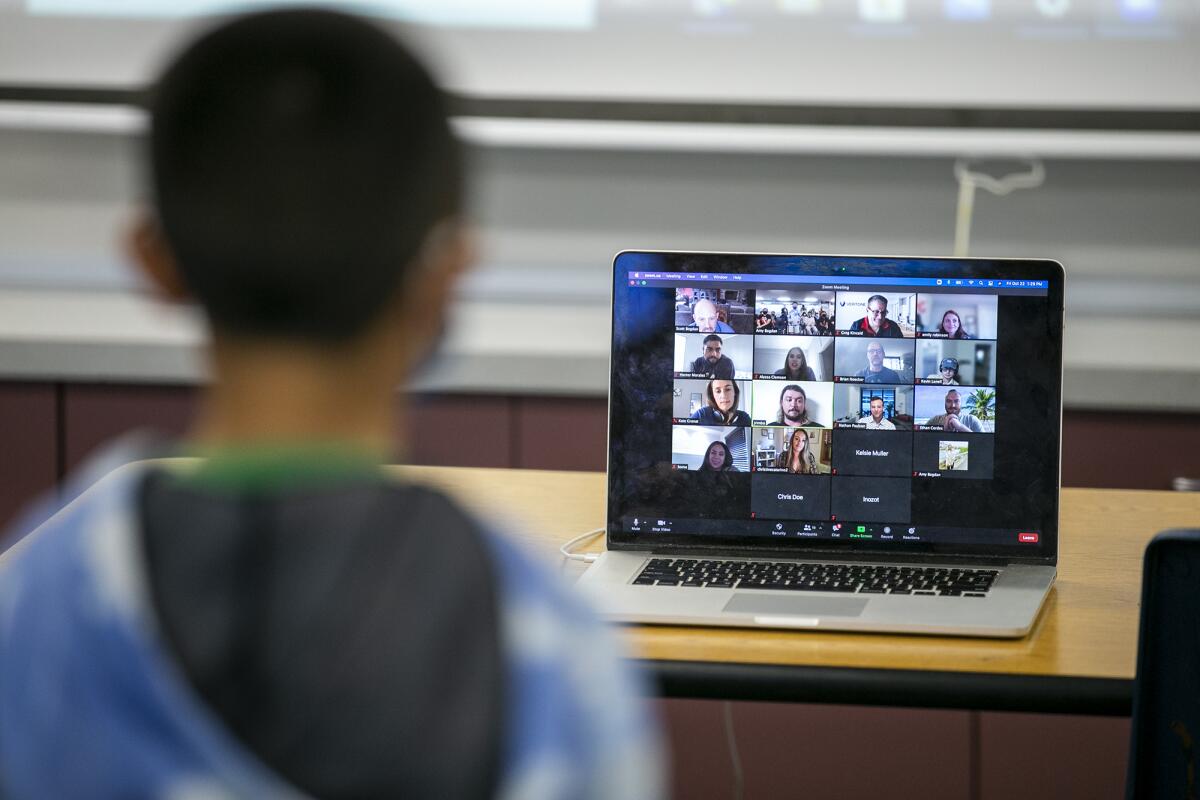Apodaca: The future is now — AI is changing the way we live

- Share via
Lately it seems as if everyone is talking about, writing about and freaking out about artificial intelligence, or AI, which uses algorithms, data and computer power to simulate human intelligence.
I offer a synopsis of the dialogue: AI is exciting. No, it’s scary. We’re only beginning to fathom its mind-blowing, world-changing potential. Actually, it’s overhyped, and the hysteria will soon pass. It will improve our lives. It will take over our lives. It will help us be smarter. It will make us dumber.
It’s tough for us regular folks to understand what’s really going on. Indeed, I’d wager that few of us actually know much beyond some reports of students using ChatGPT to assist with — sometimes even cheat at — school assignments.
And, understandably, many of us are wary. We’ve taken heed of warnings about its potential dark side. The scenarios that have been posed often call to mind the plots of many a science fiction movie about technology run amok and robots taking over the world. It’s pretty hard to ignore the concerns raised about the risk of AI someday shutting down utilities or financial markets, or even launching nukes.
Instead of doomsday prepping, however, I decided to talk to someone who knows a lot more than I do. Specifically, I wanted to know how AI will impact K-12 education. So I turned to a professional educator who has spent considerable time and energy studying this very topic.
Dr. Nancy Watkins is the director of the doctor of education program at Cal State Fullerton. A former K-12 public school educator, she has a master’s degree from Claremont Graduate School and a doctorate from UC Irvine.
Watkins was quick to characterize herself as “an explorer” of AI, rather than an expert. Regardless, she is highly knowledgeable and conversant about the emerging technology. Although cognizant of the risks, she is upbeat about its potential to improve education.
“It’s one of my favorite topics,” she said. “I think that we are seeing the next revolution in technology, with the jump that AI has been making, both with its capabilities and its possibilities.”
The first point that Watkins made was that AI isn’t just about the future — it’s already here. It’s integrated into our daily existence — from the autocorrect feature on our phones to product suggestions by AI bots on Amazon. It has been changing the way we live and behave, and it’s starting to have an impact on how educators teach and students learn.
Rather than focusing on the fears surrounding AI or on students using it to cheat, Watkins characterizes the adoption of the technology as one of “challenges and opportunities.”
From catching up after the pandemic to teacher shortages, culture wars and anxiety brought on by social media, today’s youth face a unique learning curve.
Those opportunities may come in several forms — through increased efficiency, for instance. Teachers can use AI to help organize class activities and assignments, and assist with assessments.
Watkins also believes that the potential is great for AI to improve personalized learning, achieve greater equity in education and structure more accessible, adaptable and interactive classrooms. For example, AI can be used to tailor assignments by, say, changing the reading or math level and adjusting the pace in order to best suit individual students’ needs.
Some teachers are just starting to experiment with creative ways to utilize AI. Watkins heard of one teacher who asked students to use AI to create an outline for an essay. The students would then write their own essays and compare them with AI-generated essays on the same topic, which she saw as a clever way to enhance critical thinking.
Yet many obstacles lie ahead.
Training teachers in AI is a huge challenge. Right now, attempts to do so are scattershot, and there might be some resistance. Teachers are asked to do so much; now we’re asking them to do more.
Many other downsides must be addressed. AI-generated work is hard to detect. There is a potential for bias, misinformation and privacy violations. Some AI programs have been caught making up information, a phenomenon that’s called “hallucinations.”
Great care must be taken to avoid AI becoming a crutch or a shortcut for students. Guardrails will be needed to ensure that it’s used to assist with, but not replace, students’ work. After all, as one observer put it, when it comes to learning, effort is the point.
How to fund AI development and programs is another open question. And we’re not talking about a one-time investment; as AI advances, so will the ways it can be integrated into the classroom. Educators must continually figure out how they will adjust to that dynamic environment.
We’re still in the early stages, Watkins acknowledged. AI is evolving rapidly, and we’re only beginning to understand its full potential. As it develops, the key to using AI successfully will be to consider it a partner in achieving teaching and learning goals, she said.
“AI is giving us more information. It’s giving us a different way to do things. It’s going to change the way the world operates. So I’m just saying, let’s explore.”
Point taken. The future isn’t just knocking, it’s inside the house, and it’s changing everything, education included. School districts must figure out how to manage that change before they become overwhelmed by it.
All the latest on Orange County from Orange County.
Get our free TimesOC newsletter.
You may occasionally receive promotional content from the Daily Pilot.





